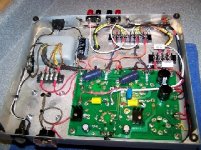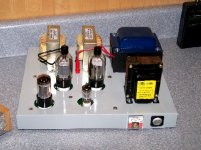Someone asked why I opted for the Hammond 374BX power transformer, instead of the more economical alternatives (such as the 274BX, or its clone the Allied 6K7VG). I briefly mentioned my power transformer concerns near the beginning of this thread but never really offered the conclusion.
In a nutshell, the 374 is built like a tank.
I think specific technical differences between the 374BX and the 274BX include:
- 374BX has a 50 volt bias winding, 274BX doesn't
- 374BX weighs 7.9 lbs, 274BX weighs 6.1 lbs
- 374BX primary voltage rated for 120 VAC, 274BX is 115VAC
- 374BX rated for 50 Hz operation, 274BX isn't
- 374BX claims "concentric wound for low stray field and low noise"
The 120VAC is important for me, since my line voltage tends to run a little on the high side. I didn't want my 6.3 volt heaters running closer to 7 volts. The 50 Hz rating means the transformer's core should be able to sustain more current when running on 60 Hz, which might net me a few more milliamps when running hungry KT88.
I have heard reports of a few 200 series Hammond transformers making a mechanical buzzing noise. The AC field in the transformer makes the windings vibrate, and the whole thing makes a low level humming noise. I listen in a quiet environment at low levels, and I won't tolerate any noise coming off the amp itself. Granted, the reports of noise have been few, but no one has ever said anything bad about the 300 series (excepting the cost).
With all that said, many people have reported excellent success with the Hammond 200 series and Allied power transformers. But, I think I must have a lot of DC on my power line or something as I've had too many amplifiers with humming power transformers. I figured that when I built my Simple SE I wasn't going to take any chances with the PT. I coughed up the extra bucks for the 374BX and I haven't been disappointed. It is one of the quietest transformers I've seen in my house. I have no regrets about the extra money I spent on it.
In a nutshell, the 374 is built like a tank.
I think specific technical differences between the 374BX and the 274BX include:
- 374BX has a 50 volt bias winding, 274BX doesn't
- 374BX weighs 7.9 lbs, 274BX weighs 6.1 lbs
- 374BX primary voltage rated for 120 VAC, 274BX is 115VAC
- 374BX rated for 50 Hz operation, 274BX isn't
- 374BX claims "concentric wound for low stray field and low noise"
The 120VAC is important for me, since my line voltage tends to run a little on the high side. I didn't want my 6.3 volt heaters running closer to 7 volts. The 50 Hz rating means the transformer's core should be able to sustain more current when running on 60 Hz, which might net me a few more milliamps when running hungry KT88.
I have heard reports of a few 200 series Hammond transformers making a mechanical buzzing noise. The AC field in the transformer makes the windings vibrate, and the whole thing makes a low level humming noise. I listen in a quiet environment at low levels, and I won't tolerate any noise coming off the amp itself. Granted, the reports of noise have been few, but no one has ever said anything bad about the 300 series (excepting the cost).
With all that said, many people have reported excellent success with the Hammond 200 series and Allied power transformers. But, I think I must have a lot of DC on my power line or something as I've had too many amplifiers with humming power transformers. I figured that when I built my Simple SE I wasn't going to take any chances with the PT. I coughed up the extra bucks for the 374BX and I haven't been disappointed. It is one of the quietest transformers I've seen in my house. I have no regrets about the extra money I spent on it.
Ty_Bower said:I have heard reports of a few 200 series Hammond transformers making a mechanical buzzing noise. The AC field in the transformer makes the windings vibrate, and the whole thing makes a low level humming noise. I listen in a quiet environment at low levels, and I won't tolerate any noise coming off the amp itself. Granted, the reports of noise have been few, but no one has ever said anything bad about the 300 series (excepting the cost).
Just to add to what Ty said here - I originally bought a Wheatfield HA-2 it had a Hammond 270HX on it that was noisy as all heck. And like Ty, my listening environment is very quiet so mechanical noise is unacceptable. So I replaced it with the 370HX and the amp was essentially silent thereafter. The 370 also ran cooler, which was comforting on an amp running its transformer that hard.
I remembered that I had pictures of before and after mods on my HA-2, this should give folks an idea of the difference in size between the 200 and 300 series trafos.
Stock HA-2
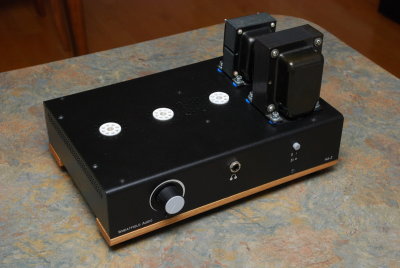
Modified HA-2
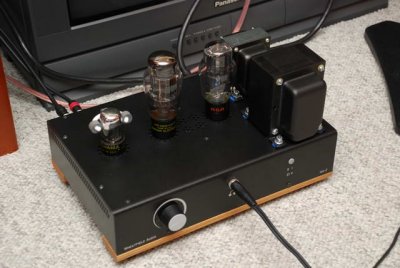
One other note, the quality of the finish on the 370HX that I got was significantly better than the 270 that came on the amp. Not that this means a thing regarding performance but I thought it might be worth nothing just the same.
Stock HA-2

Modified HA-2

One other note, the quality of the finish on the 370HX that I got was significantly better than the 270 that came on the amp. Not that this means a thing regarding performance but I thought it might be worth nothing just the same.
George speaks on output transformers:
http://www.diyaudio.com/forums/showthread.php?postid=1113169#post1113169
The thread referenced above was written over a year and a half ago. My opinions on the transformers listed has remained the same with one exception.
I have a few amps that were built "permanently". They were built on a chassis designed for that amp and remain relatively unchanged since they were built. I keep the original "Lexan" Tubelab SE as my reference standard. It uses custom Electra Print OPT's and an Allied 6K56VG power transformer for about 325 volts of B+. I can run 45's, 300B's, 183/483's and 2A3's (breifly due to excessive filament current) in this amp. This amp has been auditioned against very expensive DHT amps with good results. I also have the "industrial" Simple SE using EH KT88's with Transcendar OPT's as well as the 845SE and 300Beast P-P amps.
There are several other "amps" that remain in a constant state of change. Often the "chassis" is only a piece of wood. I use them to try new ideas, circuits, and tubes. Some of these "amps" may exist for a weekend, others may last until I get a new idea which may be several months. I have a few OPT's that get used for the SE amps. The Edcor XSE, the Edcor CXSE, the Hammond 1628SEA, the One Electron UBT-3, the Transcendar "300B transformer" and the Hammond 125CSE.
I have listened to all of these OPT's for extended periods of time with dozens of different tubes and power levels over the past year and a half. My current opinions are similar to my original statements except for the Hammond 1628SEA and the Edcor CSXE25-8-5K. My opinion was then biased against the Edcor because the measured distortion at low frequencies in UL mode(44Hz) was uncharacteristically high even at low power levels. This does not seem to translate into any audible artifacts even with large speaker systems that have no problem reproducing 44Hz. After hearing these transformers sing with 300B's VT225's and 45's (all triodes) I have learned to like them, a lot! I have cranked them up in UL with KT88's and they still sound as good as the Hammond 1628SEA, but the Hammond does have better bass.
How would you compare the CXSE's with the Transcendars, George?
First off, the Transcendars that I have are an old design that he no longer produces. I bought a dozen pairs two years ago to build 300B based Tubelab SE's, I still have a few left. They are 3Kohm, but I run the speakers on the 4 ohm tap to effect a 6K ohm load on the output tube for operation with the KT88 at 440 volts (Simple SE).
Given a choice of the two transformers with no constraints (budget or speaker capability) I would choose the Edcors. Given the fact that I got the Transcendars for half of what the Edcors cost (I bought a bunch) I put them in my Industrial amp. This amp gets daily use with a pair of Yamaha studio monitor speakers which have no response below 60 Hz so the advantage of the big Edcors gets lost. If you have speakers that can take advantage of 5 watts at 40 Hz, or budget and size are not an issue, then go for the Edcors, they do sound better even with a 45 on my little speakers.
I have a Simple SE that uses the Allied 6K56VG power transformer, 6V6GT output tubes and the smallish Edcor XSE15-8-5K OPT's. I have taken this amp apart for experiments, but it keeps finding itself back together again. This combination sounds surprisingly good for its low cost and whopping 1.5 WPC. I think that I am going to make one of these for a "permanent" amp now that the weather has become conducive to working outside again. Yeah, it is winter in North America. Here in South Florida it is the only time I gan get the table saw out.
Thanks for sharing your thoughts yet again, George.tubelab.com said:
...I have a Simple SE that uses the Allied 6K56VG power transformer, 6V6GT output tubes and the smallish Edcor XSE15-8-5K OPT's. I have taken this amp apart for experiments, but it keeps finding itself back together again. This combination sounds surprisingly good for its low cost and whopping 1.5 WPC.
My Simple SE is board has been assembled for about three weeks, waiting for work and other responsibilities to scale back a bit. I'm in the process of doing a test assembly using a 6K7VG and the Edcor XSE iron. I have an assortment of tube types to play with and an almost schizophrenic taste in music (think - Pink Floyd, Stevie Ray Vaughn and Allison Krause in the same set), so this first dalliance with tube power will be a very interesting engagement.
I think that I am going to make one of these for a "permanent" amp now that the weather has become conducive to working outside again. Yeah, it is winter in North America. Here in South Florida it is the only time I gan get the table saw out.
I know exactly what you mean. Foolishly, this past August, I built a pair of speakers in my garage here in Houston. Work on a permanent chassis for the amp over the next week or so will be more of a pleasure and less of an ordeal.
Ty_Bower said:
So I sketched this out using RS# 276-150 experimentor's board. The board itself is less than 2" x 3". The blue lines are where the 250 ohm resistors go.
....
Maybe I can try to build one this weekend.
An externally hosted image should be here but it was not working when we last tested it.
Hi Ty and guys,
When I overhauled my Simple SE, I thouht about making a daughterboard to hold multiple cathode resistors similar to your concept board.
Ultimately, I took a low tech approach and just moved them off board on a barrier strip, as shown in the picture that should attach to this post. This Simple SE can accomodate almost anything. I can change the secondaries on my pwr txfmr, plate load, degree of cathode feedback, and cathode resistors with just a screwdriver.
This board is starting to look a little rough because it has had a hard life. A lot of things have been turned up until they exploded, and then backed off a little bit!
It's a beautiful afternoon here in northwest Arkansas, so I am off to change an alternator on the truck, and hopefully work on assembling a new SteppIR if the alternator swap goes smoothly!
Win W5JAG
Attachments
I did not bother with a daughter board or anything complicated, I simply used cable ties to strap three resistors together. The resistor closest to the board is soldered to the board. This resistor is the highest value you need and is always in the cct. The other two resistors are calculated to give the two lower required resistances when parralleled with the first resistor. The other two resistors have one leg soldered to the first resistor and the other leg goes to a three position switch that is either open cct or switches either of these resistors in parrallel. Took a few minutes to wire up. Used the hole in the chassis that was used previously to switch between SS and valve rectification to put the 3 position dual pole switch. Quick, simple, effective, cheap and no extra parts or chassis work required.
Cheers,
Chris
Cheers,
Chris
w5jag said:And a top shot.
May I ask what those finals are. Anything with an anode cap gets my attention.
Jeff
vinylkid58 said:
May I ask what those finals are. Anything with an anode cap gets my attention.
Jeff
General Electric 6DQ6B.
Win W5JAG
Maybe this comes as a dumb question for yous, and you will probably go do some reading, which I honestly did. But can this amp be used as a guitar amp? Or be modified to be used as a guitar amp?
(have some mercy my nobness, that I keep proving over and over again as I post stuff on this forum)
thank you
(have some mercy my nobness, that I keep proving over and over again as I post stuff on this forum)
thank you
I have done a choke input Simple SE, but I did it differently. I used two chokes... This allows the original CLC filter to remain in place and a LCLC filter to be used for choke input.
Well, I finally got around to doing this to mine. Even before I even decided to build a Simple SE, I wanted to use this beautiful pair of 1945 vintage 6L6GA. I used them as the "models" in my chassis design concepts. Unfortunately, they told me the Simple SE voltage would be too high to safely run these tubes. The choke input seemed like a good way to drop a lot of voltage without having to swap out for a different power transformer.
I found a spot to sneak in a little Triad C-24X, which ends up being the second L in the filter. The larger Hammond 159Q is the input choke. The hardest part was cutting the trace on the circuit board - for two reasons. I hated to make a more or less permanent change to the board, even if can jumper around it later to reverse the mod. The second reason was the copper on George's board is really thick, and even with a sharp X-acto I had to work a bit to get a clear cut.
With the choke input, B+ is about 335 VDC. I'm wondering if I should make any other changes, perhaps to the cathode resistors (currently 810 ohms) or possibly jumping out R14 to account for the lowered B+. I do need to make a quick measurement of the 6L6 cathode voltage, and also of the 12AT7 plate voltage. But first, I'm going to take a little time to finally enjoy these sixty-five year old tubes.
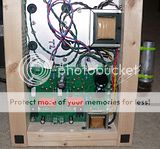
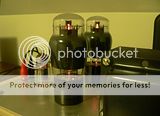
http://i69.photobucket.com/albums/i43/Ty_Bower/Simple SE/P1150138.jpg
http://i69.photobucket.com/albums/i43/Ty_Bower/Simple SE/P1150148.jpg
For the 6L6GA and 335 volts, 470 ohm would be a good starting point for the cathode resistor.
With that B+ voltage, 6V6 and 6F6 will work well. An 810 ohm cathode resistor is about right for them.
I measured the idle current for the 6L6GA, and came up with about 33.6mA average. That's only ten watts dissipated in the tube. I'll fiddle the cathode resistor and see what happens.
I popped in a pair of 6V6GT, and they sounded just fine.
I wanted to use this beautiful pair of 1945 vintage 6L6GA.
Lovely!

jeff
Lovely!
Thank you.

http://i69.photobucket.com/albums/i43/Ty_Bower/Simple SE/P1150163.jpg
Sherri and I have been sorting through, and eliminating our lifetime collections of "stuff" so that we can reduce the expense of renting storage space. During the process I discovered some boxes full of tubes that I had forgotten about. One such box contained about 20 6L6GA's and 6L6GAY's. No clue how many of them are good, but one or more projects will come from them. The easiest will be a SSE with one of the HP power transformers that I have.
Sherri and I have been sorting through, and eliminating our lifetime collections of "stuff" so that we can reduce the expense of renting storage space. During the process I discovered some boxes full of tubes that I had forgotten about. One such box contained about 20 6L6GA's and 6L6GAY's. No clue how many of them are good, but one or more projects will come from them. The easiest will be a SSE with one of the HP power transformers that I have.
Hello Gents,
House cleaning and sorting memories in California too. I put my hands on my stuffed but never tested SSE, Allied 540 volt CT PT. Triad 6H choke, 70uf motor run capacitor and the best part. The best part is a repurposed chassis with a Aerojet General property sticker on it. Aerojet builds rocket engines. When I was a kid in Boy Scouts we went to visit a MIT PhD’s home DIY shop. The guy was a metallurgist and head of the Aerojet foundry where they cast rocket engine nozzles. In his home shop he built custom engineered race boat turbochargers, intake manifold, and propellers. He built them from the ground up not some GM or MoPar stuff.
I was hooked on mechanical engineering and DIY. Sorry for the digression.
DT
All just for fun!
- Status
- This old topic is closed. If you want to reopen this topic, contact a moderator using the "Report Post" button.
- Home
- More Vendors...
- Tubelab
- Another Simple SE builder
